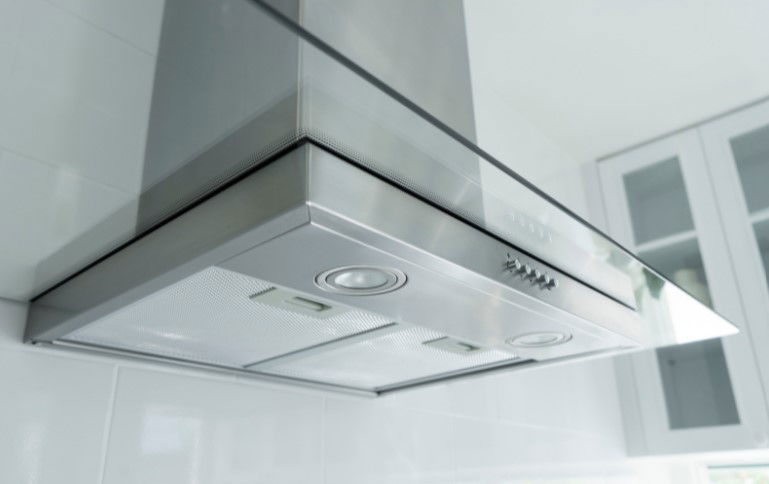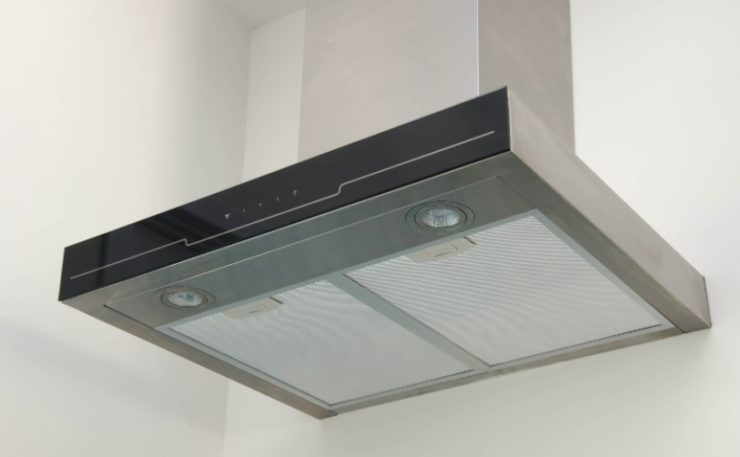If you’re looking for a range hood that efficiently clears smoke, grease, and cooking smells from the kitchen, it will make some noise. But how much noise is too much noise?
It’s simple. If you hear any sound other than that of the fan moving, it needs to be cleaned or repaired. This is probably because of a grease deposit on the hood filter or fan blade, faulty insulation, an old motor, or a damaged hood fan.
If you’re looking to replace your range hood, here are 3 of the quietest range hoods to consider. But replacing the entire hood takes a lot of time and effort. So before you get started on your research, here are five simple things you can try and do to make your range hood quieter.

In This Article
Run Your Range Hood at a Lower Speed
Most range hoods have a provision for altering the fan speed. Running it at a lower speed is the easiest and most effective way to reduce fan noise.
The larger and more powerful range hoods have the ability to provide proper ventilation at lower and quieter speeds. But make sure you have high-quality grease filters to absorb more cooking odors and particles even when it is running at a low speed (about 600 revolutions per minute).
But keep in mind that sometimes it is essential to switch between different fan speeds depending on the air condition in your kitchen, especially when cooking multiple things in the kitchen. So to reduce the noise, you can try the other methods suggested.
Clean Greasy Hood Filters
Every range hood has grease filters that can catch debris and grease particles before they reach the exhaust fan. But if that filter gets clogged, it can really make the hood inefficient and extremely noisy.
Cleaning the hood filters is a great first step when the range starts to become noisy and look clogged. You can easily remove these filters in most range hoods once you open the vents.
It is usually suggested that one should clean these filters thoroughly every few weeks. One simple way of cleaning them is by taking a bucket of hot water and adding Oxi Clean (or degreaser or simple dish soap). Then soak the filters in it for about 20 minutes, followed by a rigorous scrubbing. Then rinse and dry them completely before you re-attach them.
But if you own a ductless range hood, make sure you replace the charcoal filters regularly.
Increase to a Larger Duct Size
Ducts are the channels that carry the stale air from the range hood to the outdoors. When the noise gets compressed in a narrow, enclosed space the sound is amplified and loud.
A great way to make the range hood quieter is to install wider and shorter ducts with fewer bends on them. It is always advisable to select a duct that is at least the same size as the blower (the diameter of the ductwork should be equal to or greater than that of the blower). In a larger duct, it is easier for air to flow through it as there won’t be as much resistance in it, allowing the hood to run more efficiently and quietly.
Another tip to keep in mind while choosing the duct pipe is that the material of the pipe should be more flexible and not rigid since rigid duct pipes tend to vibrate and make more noise when air passes through them.
Lubricate the Range Hood Motor
Every motor needs lubrication to run smoothly, and the range hood motor is no different. Most kitchen fans don’t require a lot of maintenance and care to run properly, but lubrication can only help when it comes to an exhaust fan that runs for so many hours every day.
The hood motor probably needs relubrication if you hear a loud humming, grinding, or squeaking sound. The process is quite simple. Remove the fan’s grill panel and clean the fan with a damp rag. Then using the narrow straw tip of the lubricant, spray or apply a few drops of it into the tiny joints of the fan.
In a nutshell, lubrication reduces friction in the fan’s movement, making the motor run smoothly and quietly.
Replace the Old Hood Fan
Most solutions to how to fix a noisy range hood fan are running maintenance or repairs. But if those solutions don’t make the range hood quiet, then your best bet is to replace the old hood fan.
It is highly probable that due to wear and tear, the existing hood fan is either broken or just too old to work properly.
When looking to replace it with a new fan, look for the sone units mentioned on the box. I would recommend getting one that makes five sones or less when powdered.
You may also want to consider buying a bigger fan if you feel the current one is being overused for its size.
The Bottom Line
To sum it up, replacing the old fan, lubricating the motor, increasing the duct size, cleaning the filter, and running the fan at lower speeds are a few handy ways of reducing the noise in your kitchen exhaust.
If these don’t help reduce the noise considerably, you may want to check if your range hood has a high enough CFM for your kitchen. Here is a quick guide on how to choose the best CFM for your range hood.
FAQ
How Do You Cover A Kitchen Exhaust Fan?
A great way to hide the range hood is by making it camouflage with the kitchen decor. You can insert the range and vent hood and surround it with drywall. This way, the entire range hood will not stand out, and if you want, you can even paint the drywall the same color as the rest of the kitchen.
Where does the air go in a kitchen exhaust fan?
When you turn on the exhaust fan, the grease particles and cooking smoke get sucked up into the bottom part of the hood (where the grease filters are). These filters trap the large grease particles, and the remaining smoke and air flow through the exhaust duct, ultimately reaching the outdoors.
How often should you change your kitchen exhaust filter?
If you use the range hood moderately, the exhaust filters should be cleaned every few weeks and be changed 1-2 times a year. If you use it more than average, then make sure to clean or change them more frequently. If you have a ductless range hood, then you should change the charcoal filters regularly.







